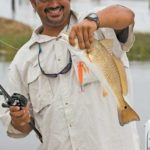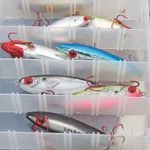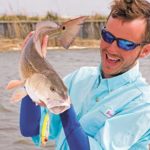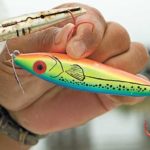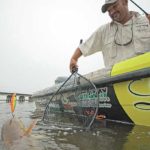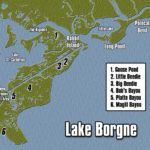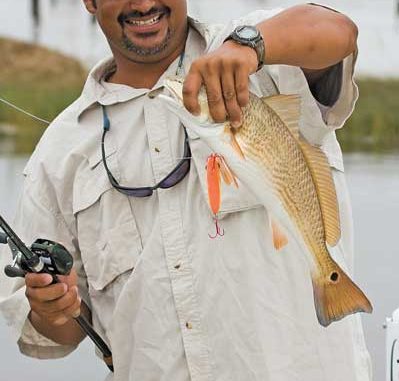
Fishing the bridges of Lake Pontchartrain can get monotonous, but there’s nothing boring about watching redfish slam topwaters just a little farther to the east.
When Capt. Eric Dumas sped past the three bridges that span the eastern section of Lake Pontchartrain, I thought we might be going to fish the L&N train bridge farther to the east in the Rigolets. As he sped under it, I knew something was up.
Dumas, one of Lake Poncthartrain’s best at pulling giant speckled trout from the busy bridges, had something else in mind.
“You ever catch a bunch of big redfish on topwaters?” he asked.
I informed Dumas that I had thrown topwaters for reds from Venice to Calcasieu, but throwing them at reds in the Pontchartrain Basin was something that I had never done. I mean, people go to Pontchartrain to catch trout off the bridges, don’t they? Can’t say I knew of anybody who purposely went there to catch redfish on the surface.
We didn’t go far on the other side of the L&N bridge, and Dumas pulled back on the throttle of this 24-foot Ranger bay boat near some scattered pilings just in front of a point near the northern shoreline.
“We’ve been catching a ton of reds here the last few days,” he said. “I love catching those big trout, but when these big boys are in shallow and feeding, there’s not much better than watching them knock the eyes out of these topwaters.”
Along for the ride was Sam Elliott, an avid saltwater angler from Luling. All three of us started slinging MirrOlure She Dogs and She Pups around the scattered grass along the broken shoreline. The action was almost immediate, and it was obvious why Dumas likes to sneak off from the bridges every now and then.
“It’s good to get away from the bridges and get some different scenery,” he said. “It gets old looking at piling after piling, not to mention how stressful it is on the ears. Fishing over here is like leaving the city and going to the country.”
Dumas explained that the reds we were catching were positioned on top of an oyster reef that attracted hungry fish on and off throughout the summer. While we were there during the later part of the summer, Dumas went on to explain that beginning in May, the entire western shoreline starting at Polecat Bend to the north and extending all the way through Long Point and down to Alligator Point would have some excellent topwater redfish action.
Between battling big redfish, Dumas said the key to finding them and catching them is to fish all the little cuts and pockets along this entire stretch of shoreline. Since that is such a long stretch, I inquired how somebody could go about eliminating some water so they could quickly get on the topwater redfish bite.
“You can ride around a little and look for baitfish flipping around,” said Dumas. “Sometimes you can see their tails out the water like this spot we’re fishing right here. I pulled up here yesterday, and there were 50 tails out the water waving at us.
“But the best way to find the bite is to fish during the best conditions — incoming tide with a southeast wind.”
An incoming tide is important to feeding reds because it puts them on the bank searching for food. Add a southeast wind that muddies the water and stirs up the bait and crabs, and you’ve got conditions tailor-made for fooling reds with topwaters.
I badly wanted to ask Dumas why anybody would throw a topwater for redfish when a dead shrimp fished under a cork would do just as well, but I didn’t want to seem too stupid. Asking that would have been like asking why anybody would want to dance with Jessica Biel when Ugly Betty would do just as well.
His answer would have had something to do with the thrill factor, so I kept my mouth shut and dutifully continued casting. While we were getting slammed about every fifth cast or so, I noticed that we were also getting lots of blow-ups from reds that never even got the bait in their mouths.
“That’s probably the No. 1 tip I could give somebody who’s not used to fishing topwaters for redfish,” Dumas said. “Their mouths are on the bottom of their noses, so it’s awkward for them to hit something on the surface.
“It may take them two or three tries before they actually get it in their mouths. That’s why you’ve got to wait to feel the weight of the fish before you set the hook. If you set on the blow-up, you’ll miss a lot more fish.”
Although we never had to move, Dumas pointed out that big schools of reds could frequently be found cruising up and down the Lake Borgne shorelines. They are easy to spot because it’s hard to miss 30 or 40 reds swimming together in a pack.
Dumas explained the importance of staying on the side of the pack with your trolling motor, and continually casting in front of the school.
“If you cast behind those moving reds, you’ll never get bit,” he said. “By casting in front, it’s kind of like leading a bird. You want to be walking your bait so that it meets up and crosses their path.”
Since our biceps were burning from a build up of lactic acid brought on by catching more than 40 big reds, Dumas, Elliot and I decided to pack it up and head in. Before he cranked his motor, Dumas had one more piece of advice to pass along.
“Out here, you can crush the reds one day, and they won’t be anywhere around the next,” he said. “So don’t get locked in to fishing one spot over and over because they’ll burn you like that. If you aren’t getting bit where you caught them yesterday, move around and look for some new spots. You’ll find them.”
Dumas called me later that week to tell me he had caught and released more than 300 redfish from this same general area during the week we were on the water. With that kind of action taking place, I wondered if any other Pontchartrain speckled trout slayers ever ventured over to Lake Borgne to get in on the topwater redfish bite.
I eventually found one.
“I’m not a topwater redfish genius,” said Chas Champagne, “but I know what everybody else knows. I wouldn’t say topwaters are the most effective way to catch reds, but fishing them sure does rate highly in entertainment value.”
Champagne is kind of like Dumas in that he likes to get off the hustle and bustle of the bridges every now and then so he can enjoy himself a little more. In fact, it blows his mind that the redfish bite around the Pontchartrain Basin isn’t taken advantage of by more anglers.
“Let’s be honest,” he said. “Fishing the bridges is not the most enjoyable fishing trip in all the world. There’s this big craze over the bridges, and whatever, but once you’ve caught a 4- or 5-pound trout, you’ve done seen it all. I mean, it blows my mind that there will be 50 boats on one bridge and not one boat anywhere else.”
In fact, there are many times that Champagne launches with the intent of fishing the bridges, and he will make a detour and throw some topwaters for reds if it’s a nice, calm morning. He likes to get in the little duck ponds around Alligator Point on the Lake Borgne side, and he hits the reds until about 8 or 9 in the morning.
Anglers who really want to catch redfish before hitting the bridges should focus on fishing more of the pond-type stuff around Bayou McGill, Star Bayou, Bayou Platte, Bob’s Bayou, Little and Big Deedie, and the ever-popular Goose Pond, which everybody seems to know about.
“I’m a big Zara Spook fan,” said Champagne. “All the MirrOlures are great, but I find it’s a lot easier to walk the Spook. And now that Bomber has the new Walkie Talkie that has the high-pitched sound, I can throw an easy-to-walk bait that sounds like a She Dog.
“And although lots of people fish topwaters on braid, I know they’re a lot easier to walk if you put a mono leader. That also keeps the braid from wrapping around your hooks.”
Although Dumas and Champagne earned their reputations by slamming speckled trout on the bridges, both anglers enjoy taking the time to head east to try the redfish action. And since they’re looking for a little excitement, you can bet they’re not going to be fishing dead shrimp under a cork. They’re looking for a change of pace, so it’s got to be topwaters for them.
Contact Capt. Eric Dumas at 985-705-1244. Follow the author’s blog at www.chrisginn.com.
